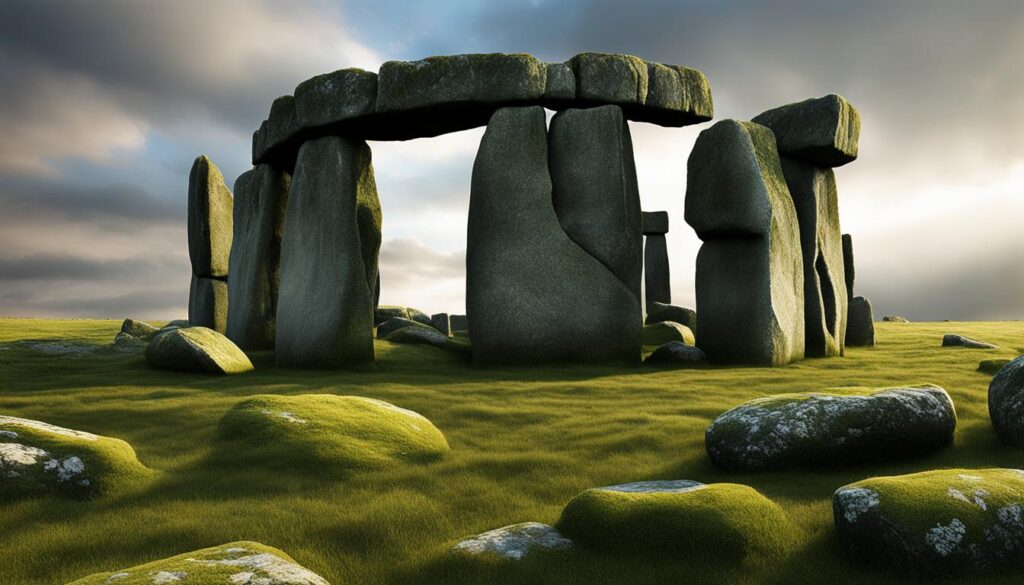What is the Heaviest Stone in Stonehenge: Stonehenge, the remarkable ancient monument located in Wiltshire, England, continues to captivate our imagination with its mysterious origins and awe-inspiring construction. As we delve into the secrets of Stonehenge, one question stands out: What is the heaviest stone in Stonehenge?

The answer lies in the magnificent Heel Stone, a massive sarsen stone that holds the title for being the heaviest stone in Stonehenge. Weighing approximately 30 tons, the Heel Stone is a testament to the incredible engineering skills and architectural achievements of the Neolithic people who built this iconic structure.
The Heel Stone, made of silcrete rock, is one of the largest stones in the entire monument. Its weight surpasses that of the other stones at Stonehenge, which on average, weigh around 25 tons. The smaller bluestones, which have their own significance, weigh between 2 and 5 tons each.
The construction of Stonehenge required the efforts of hundreds of people who not only transported these massive stones but also shaped and erected them with astonishing precision. The Heel Stone’s weight and size are a testament to the immense challenges faced by the ancient builders.
What is the Heaviest Stone in Stonehenge: Key Takeaways
- The heaviest stone in Stonehenge is the Heel Stone, weighing approximately 30 tons.
- Sarsen stones, like the Heel Stone, make up the majority of the stones at Stonehenge, with an average weight of 25 tons.
- The bluestones, smaller in size, weigh between 2 and 5 tons each.
- The Heel Stone’s weight showcases the incredible engineering skills of the Neolithic people.
- Stonehenge stands as a testament to the architectural prowess and engineering capabilities of the ancient builders.
The Construction of Stonehenge
The construction of Stonehenge was a complex and well-organized process. The first monument at Stonehenge was a circular earthwork enclosure, built around 3000 BC. It consisted of a ditch and an inner and outer bank, with a ring of timber or stone posts inside the ditch. These posts were used for cremation burials. In about 2500 BC, the central stone settings were constructed at Stonehenge, which transformed the site into its iconic form. Enormous sarsen stones, weighing approximately 25 tons each, were raised to create the outer circle and inner horseshoe of Stonehenge. These stones were sourced from the Marlborough Downs, about 20 miles away from the site, specifically from an area known as West Woods.
The construction of Stonehenge required careful planning and organization, as well as the use of tools like hammerstones, ropes, antler picks, and timber. The megalithic structure stands as a testament to the architectural prowess and engineering capabilities of the ancient people who built it.
To What Extent can Intrapersonal Conflict Affect Job Performance When Employed
Stonehenge Construction Materials
Stonehenge is primarily made up of two types of stones: the sarsen stones and the bluestones. The sarsen stones are large sandstone blocks sourced from the Marlborough Downs, known for their durability and strength. These stones were used to build the iconic outer circle and inner horseshoe. The bluestones, on the other hand, are smaller stones, typically weighing between 2 and 5 tons each. They were sourced from the Preseli Hills in Wales, approximately 180 miles away from Stonehenge. The exact reason why these bluestones were transported such a long distance remains a mystery.
Megalithic Structures and Neolithic Architecture
Stonehenge is an exceptional example of megalithic architecture, characterized by the use of large stones in construction. Megalithic structures were common in the Neolithic period, and they served various purposes, including ceremonial, religious, and astronomical functions. These structures showcased the immense skills and knowledge of the ancient builders, who managed to transport and position these massive stones with precision and ingenuity.
Stonehenge stands as a testament to the architectural prowess and engineering capabilities of the Neolithic people.
Stonehenge – Historical Facts
- The construction of Stonehenge started around 3000 BC.
- The sarsen stones, weighing around 25 tons each, were used to create the iconic outer circle and inner horseshoe.
- The bluestones, smaller stones weighing between 2 and 5 tons, were sourced from Wales.
- The exact purpose and significance of Stonehenge remain a topic of debate and speculation.
Stonehenge Stone Comparison
| Stone type | Weight | Source |
| Sarsen stones | Approximately 25 tons each | Marlborough Downs |
| Bluestones | Between 2 and 5 tons each | Preseli Hills, Wales |
By using these massive stones, the Neolithic builders created an enduring monument that continues to captivate and baffle observers to this day. Stonehenge stands as an extraordinary feat of ancient engineering and a testament to the advanced skills and knowledge of its builders.
Significance of Stonehenge
Stonehenge, one of the most famous ancient stone monuments in the world, holds immense cultural and historical significance. This renowned English Heritage site continues to captivate us with its mysterious allure and unanswered questions. The enigmatic purpose and construction of Stonehenge intrigue both visitors and historians.
Tourists from all over the world flock to Stonehenge to witness its grandeur and delve into the rich history that surrounds it. As they admire the colossal stones and marvel at the architectural wonders of the past, they can’t help but ponder the ancient mysteries that shroud the monument.
Archaeological research has brought invaluable insights into the history of Stonehenge. It has revealed that the site served as a burial ground, shedding light on the rituals and beliefs of the people who built it. The monument’s alignment with the solstices hints at a possible astronomical significance, adding to the intrigue and fascination surrounding it.
Stonehenge is far more than just a stone circle; it represents the remarkable achievements of ancient civilizations that thrived in the region. This awe-inspiring testament to their architectural and engineering prowess stands strong, intertwining the past and present as a beacon of our collective history.
FAQ
What is the heaviest stone in Stonehenge?
The heaviest stone in Stonehenge is called the Heel Stone, which weighs about 30 tons.
What is the weight of the stones in Stonehenge?
The sarsen stones at Stonehenge weigh around 25 tons on average, while the bluestones weigh between 2 and 5 tons each.
What are the significant features of Stonehenge construction materials?
Stonehenge was built using sarsen stones, which are made of silcrete rock. These stones were sourced from the Marlborough Downs, about 20 miles away from the site.
What are some historical facts about Stonehenge?
Stonehenge is a remarkable ancient monument located in Wiltshire, England. It was constructed during the Neolithic period with simple tools and technology.
Why is Stonehenge a significant monument?
Stonehenge holds immense cultural and historical significance as a renowned English Heritage site and one of the most famous ancient stone monuments in the world.
What is the archaeological significance of Stonehenge?
Stonehenge provides valuable insights into the history of ancient civilizations and their remarkable achievements in architecture and engineering. It also serves as a burial ground.
